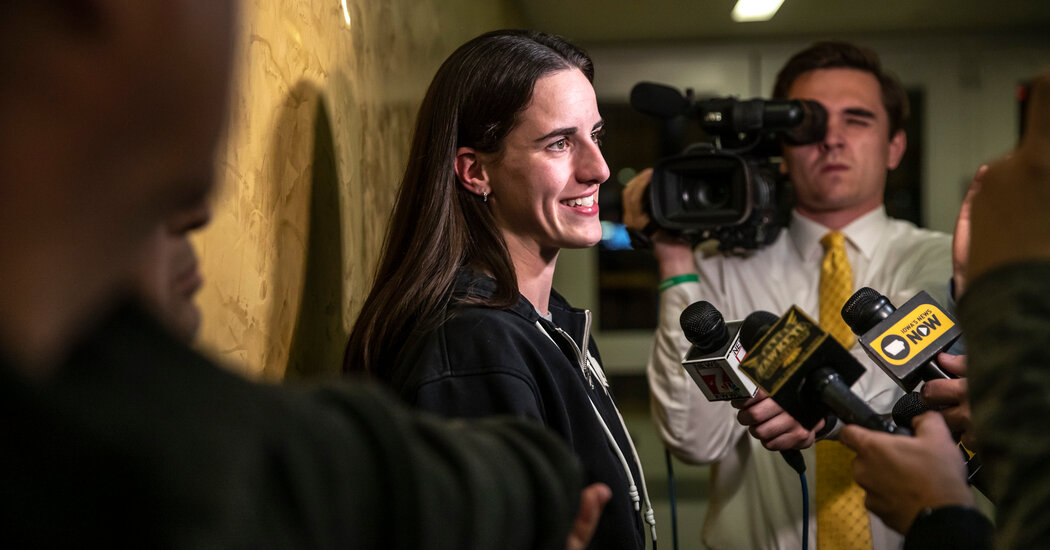Caitlin Clark, the University of Iowa basketball player who has dazzled crowds with her deep shooting range and preternatural scoring ability, is one of the biggest draws in sports.
Tickets to her games this season were nearly 200 percent more expensive than they were last year, according to Vivid Seats, a ticket exchange and resale company. Fans routinely traveled hundreds of miles to catch a glimpse of her, lining up for hours before tipoff and boosting local economies.
Nearly 10 million people, a record, watched her play in last year’s championship game, a loss to Louisiana State. More than three million tuned in this year when she set the career record for points scored by a Division I college basketball player.
Now, as Ms. Clark prepares for her final N.C.A.A. tournament — No. 1-seeded Iowa plays its first game on Saturday — excitement has reached a fever pitch. It has some wondering if Ms. Clark’s effect on the popularity of women’s sports, and their economics, will linger after her career at Iowa ends.
Viewership, juiced by media rights deals, and corporate sponsorships are the key drivers of revenue for college and professional sports. In women’s sports, those have long lagged behind what men’s sports receive. In 2019, for instance, women’s sports programming accounted for less than 6 percent of coverage on ESPN’s “SportsCenter,” according to a study.
But in recent years, women’s sports have had significant growth. A November report from Deloitte projected that women’s sports would generate more than $1 billion in global revenue this year, up roughly 300 percent from the company’s estimate in 2021. Globally, the number of sponsorships in women’s professional leagues increased 22 percent in 2023, compared with a 24 percent increase in men’s sports, according to SponsorUnited, which tracks company sponsorships and deals.
“You do need women like Caitlin Clark who are so great that you can’t miss them,” said Michael Pachter, a tech analyst for Wedbush Securities.
Stars do make sports. The men’s national title game in 1979 between Magic Johnson’s Michigan State and Larry Bird’s Indiana State remains the most-watched college basketball game of all time. Both stars then entered the National Basketball Association, making the league more popular than it had ever been.
Before the Johnson-Bird N.B.A. era, the league’s finals were broadcast on tape delay. Today, the N.B.A. earns billions of dollars from its television deals, and star players make more than $60 million per season.
And as TV networks have tried to give viewers reasons to tune in during the streaming era, the rights to broadcast popular men’s sports, like football, hockey and basketball, have become expensive. That has spurred networks to lock in deals to broadcast sports, like women’s basketball, that don’t cost as much and whose viewership is projected to grow.
“The networks have run into an economic problem where they’re paying too much for the sports that they need to fill up their network space,” said Andrew Barrett, a managing director of STS Capital Partners who works in sports management. “You start to look at female sports because people will watch those.”
In January, the N.C.A.A. signed a deal with ESPN that valued the annual rights to broadcast the women’s basketball tournament at more than $60 million, more than 10 times what the network paid in the previous deal, in 2011.
The network pays $25 million to $33 million per year to broadcast some Women’s National Basketball Association games, while Scripps reportedly pays $13 million per year. The W.N.B.A.’s previous deal, solely with ESPN, was signed in 2013 for $12 million per year, according to Sports Business Journal. Annual revenue nearly doubled from $100 million in 2019 to around $200 million in 2023, according to Bloomberg.
“We’re not a charity,” Cathy Engelbert, the W.N.B.A. commissioner, said during a recent panel discussion with the law firm Kramer Levin. “We’re a real sports media and entertainment property.”
When Ms. Clark said she would forgo her final year of college eligibility to enter this spring’s W.N.B.A. draft, it had an immediate effect. The Indiana Fever, who are expected to select her with the No. 1 overall pick in April, saw a more than 200 percent increase in the average listed price of their season opener, according to Vivid Seats.
Ms. Clark’s success follows decades of progress for women in sports, dating to the 1972 passage of Title IX, which prohibits sex-based discrimination in educational settings and led to skyrocketing funding of — and participation in — women’s sports. The World Cup that the U.S. women’s soccer team won in 1999 spurred interest and investment at the youth level. Serena Williams changed the audience for tennis, and athletes like the racecar driver Danica Patrick and the fighter Ronda Rousey brought new viewers to their sports.
Andrew Zimbalist, a professor of economics at Smith College, said Ms. Clark’s success was “another event in a long line of events” that had boosted the acceptance of all women’s sports.
“There’s been a positive evolution since Title IX was passed in 1972,” Mr. Zimbalist said.
Unlike previous generations, Ms. Clark has been able to immediately reap the rewards of her fame because of an N.C.A.A. rule change in 2021 that allows college athletes to profit off their own name, image and likeness, including through product endorsements and sponsorship deals. Ms. Clark’s sponsorship deals — valued at $3 million, according to On3, a site that tracks N.I.L. deals — means she earns more than most W.N.B.A. players. (Her projected base salary for her rookie season is $76,000.)
Ms. Clark is hardly the first female basketball star to generate intense interest. The W.N.B.A. was founded in large part because of the popularity of women’s college basketball. Storied programs like the University of Tennessee and University of Connecticut collected multiple championships and featured stars like Tamika Catchings, Chamique Holdsclaw, Candace Parker, Rebecca Lobo, Sue Bird and Diana Taurasi.
But the progress has come in fits and starts. In 1997, the W.N.B.A.’s inaugural season, average attendance was around 10,000. Three years later, the league expanded to 16 teams. In 2023, there were only 12 teams, and average attendance was less than 7,000. The 2023 finals averaged 728,000 viewers, an improvement from 2022 but fewer than the 2003 finals, which were watched by an average of 848,000.
Mr. Pachter said he didn’t think the audience for women’s basketball would reach hundreds of millions overnight. But he sees interest continuing to steadily grow, and can envision a future where a streaming service may try to own the exclusive rights to a league like the W.N.B.A. For that to happen, other stars need to step up to Ms. Clark’s level.
“You need three or four more, but they’re coming,” Mr. Pachter said. “They’re going to emerge because now we’re paying attention.”

